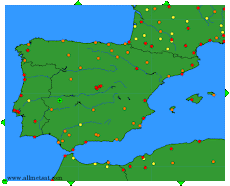Source: www.skybrary.aero
Categories: Weather | Operational Issues
This article covers the subjects of Wind Shear, Low Level Wind Shear, and Low-level Wind Shear Alert System
Definition
Wind shear is defined as a sudden change of wind velocity and/or direction.
Windshear may be vertical or horizontal, or a mixture of both types. ICAO defines the vertical and horizontal components of wind shear as follows:
Vertical wind shear is defined as change of horizontal wind direction and/or speed with height, as would be determined by means of two or more anemometers mounted at different heights on a single mast.
Horizontal wind shear is defined as change of horizontal wind direction and/or speed with horizontal distance, as would be determined by two or more anemometers mounted at the same height along a runway.
Description
Low Level Turbulence which may be associated with a frontal surface, with thunderstorms or convective clouds, or with microbursts, is particularly hazardous to aircraft departing or arriving at an aerodrome. Wind shear is usually associated with one of the following weather phenomena:
• Frontal surfaces;
• Jet streams;
• Thunderstorms or convective clouds especially cumulonimbus or towering cumulus;
• Mountain Waves;
• Microbursts.
Effects
The main effects of wind shear are:
• Turbulence;
• Violent air movement (up- or down-draughts or swirling or rotating air patterns);
• Sudden increase or reduction of airspeed;
• Sudden increase or decrease of groundspeed and/or drift.
Clear Air Turbulence (CAT), which may be very severe, is often associated with jet streams.
Rotor action or down-drafts in the lee of mountain waves can create difficult flying conditions and may even lead to loss of control.
Defences
Effective defence against wind shear comprises the following components:
Forecasting, recognition and avoidance of wind shear (see below), aided by LLWAS (see below) and airborne avionics equipment; and,
Correct response to wind shear encountered during the takeoff, initial climb, approach and landing phases of flight.
Typical Scenarios
An aircraft on initial climb encounters a microburst with strong down-drafts, which prevent the aircraft from climbing away, even though the pilot immediately recognises the wind shear and takes correct action.
An aircraft on approach in head-wind conditions encounters horizontal wind shear resulting in a change of wind component to tail-wind; the aircraft touches down late and fast and overshoots the runway.
Solutions
Improved forecasting of wind shear;
Improved training in wind shear recognition, avoidance and recovery;
More widespread use of ground and airborne wind shear warning systems.
Low Level Wind Shear Alert System
A Low-level Wind Shear Alert System (LLWAS) is a ground-based system for detecting the existence of wind shear close to an aerodrome.
The system comprises from 6 to 33 anemometers located at various points on the aerodrome surface. Data from the anemometers are fed into a computer which compares the wind speed and direction measured at the different points and provides a warning in the air traffic control tower if a hazardous wind shear is detected. Warnings are runway-specific and are passed to pilots by VHF communication.
LLWAS was first installed in USA in the 1970s and is in widespread use in that country. LLWAS has never been installed in Europe. LLWAS is gradually being replaced by Terminal Doppler Weather Radar (TDWR).
Wind Shear Recognition and Avoidance
Flight Safety Foundation (FSF) Approach-and-landing Accident Reduction (ALAR) Briefing Note 5.4 — Wind Shear points out that "Flight crew awareness and alertness are key factors in the successful application of wind shear avoidance techniques and recovery techniques."
Whenever wind shear conditions are forecast, or reported by other aircraft, pilots should include discussion of wind shear recognition and response in the takeoff or approach brief.
Whether or not wind shear conditions are expected, the pilot must be able to recognise quickly when wind shear is affecting the aircraft. He/she may be aided in this by airport based warning systems (e.g. LLWAS) or by onboard equipment, such as Ground Proximity Warning System or Airborne Wind Shear Warning Systems.
ALAR Briefing Note 5.4 lists the following indications of a suspected wind shear condition:
• "Indicated airspeed variations in excess of 15 kts, 27.78 km/h, 7.71 m/s;
• Groundspeed variations (decreasing head wind or increasing tail wind, or a shift from head wind to tail wind);
• Vertical-speed excursions of 500 fpm or more;
• Pitch attitude excursions of five degrees or more;
• Glideslope deviation of one dot or more;
• Heading variations of 10 degrees or more; and,
• Unusual autothrottle activity or throttle lever position."
Wind Shear on Takeoff and Initial Climb
Horizontal and/or vertical Wind Shear on take off result in sudden loss of airspeed and/or reduction in climb rate, with potentially disastrous consequences. It is vital that such conditions should be quickly recognised if they are encountered, and that pilot response should be immediate and correct.
Before Departure:
Flight Safety Foundation (FSF) Approach-and-landing Accident Reduction (ALAR) Briefing Note 5.4 recommends that whenever wind shear conditions are forecast or reported for take off, pilots "should include in their departure briefing the following wind shear awareness items:
• Assessment of the conditions for a safe takeoff based on: Most recent weather reports and forecasts; Visual observations; and, Crew experience with the airport environment and the prevailing weather conditions; and,
• Consideration to delaying the takeoff until conditions improve."
"If wind shear conditions are expected," the Briefing Note continues, "the crew should:
• Select the most favorable runway, considering the location of the likely wind shear/downburst condition;
• Select the minimum flaps configuration compatible with takeoff requirements, to maximize climb-gradient capability;
• Use the weather radar (or the predictive wind shear system, if available) before beginning the takeoff to ensure that the flight path is clear of hazards; • Select maximum takeoff thrust;
• After selecting the takeoff/go-around (TOGA) mode, select the flight-path-vector display for the monitoring pilot (PM/PNF), as available, to obtain a visual reference of the climb flight path angle; and,
• Closely monitor the airspeed and airspeed trend during the takeoff roll to detect any evidence of impending wind shear."
Wind Shear Recovery
The Briefing Note advises that "If wind shear is encountered during the takeoff roll or during initial climb, the following actions should be taken without delay:
• Before V1: The takeoff should be rejected if unacceptable airspeed variations occur (not exceeding the target V1) and if there is sufficient runway remaining to stop the airplane;
• After V1: Disconnect the autothrottles (A/THR), if available, and maintain or set the throttle levers to maximum takeoff thrust; Rotate normally at Vr; and, Follow the FD pitch command if the FD provides wind shear recovery guidance, or set the required pitch attitude (as recommended in the aircraft operating manual (AOM)/quick reference handbook (QRH));
• During initial climb: Disconnect the A/THR, if available, and maintain or set the throttle levers to maximum takeoff thrust; If the autopilot (AP) is engaged and if the FD provides wind shear recovery guidance, keep the AP engaged; or, Follow the FD pitch command, if the FD provides wind shear recovery guidance; or, Set the required pitch attitude (as recommended in the AOM/QRH); Level the wings to maximize the climb gradient, unless a turn is required for obstacle clearance; Closely monitor the airspeed, airspeed trend and flight-path angle (as available); Allow airspeed to decrease to stick shaker onset (intermittent stick shaker activation) while monitoring the airspeed trend; Do not change the flaps or landing-gear configurations until out of the wind shear condition; and, When out of the wind shear condition, increase airspeed when a positive climb is confirmed, retract the landing gear, flaps and slats, then establish a normal climb profile."
Wind Shear on the Approach and Landing
Horizontal and/or vertical wind shear during the approach can result in sudden loss of airspeed and apparent loss of power, with potentially disastrous consequences. A sudden change of wind component or drift prior to landing can make the approach unstable at a point where go-around is not possible or would be extremely hazardous. It is vital that such conditions should be quickly recognised if they are encountered, and that pilot response should be immediate and correct.
Descent Briefing
Flight Safety Foundation (FSF) Approach-and-landing Accident Reduction (ALAR) Briefing Note 5.4 recommends that whenever wind shear conditions are forecast or reported approach and landing, the approach briefing should include the following:
• "Based on the automatic terminal information service (ATIS) broadcast, review and discuss the following items: Runway in use (type of approach); Expected arrival route (standard terminal arrival (STAR) or radar vectors); Prevailing weather; and, Reports of potential low-level wind shear (LLWAS warnings, TDWR data); and,
• "Discuss the intended use of automation for vertical navigation and lateral navigation as a function of the suspected or forecasted wind shear conditions."
The briefing note contains some valuable recommendations for preparation and flight procedures. The section concerning Recovery during Approach and Landing is reproduced below.
Recovery During Approach and Landing
"If wind shear is encountered during the approach or landing, the following recovery actions should be taken without delay:
• Select the takeoff/go-around (TOGA) mode and set and maintain maximum go-around thrust;
• Follow the Flight Director pitch command (if the FD provides wind shear recovery guidance) or set the pitch-attitude target recommended in the AOM/QRH;
• If the AP is engaged and if the FD provides wind shear recovery guidance, keep the AP engaged; otherwise, disconnect the AP and set and maintain the recommended pitch attitude;
• Do not change the flap configuration or landing-gear configuration until out of the wind shear;
• Level the wings to maximize climb gradient, unless a turn is required for obstacle clearance;
• Allow airspeed to decrease to stick-shaker onset (intermittent stick-shaker activation) while monitoring airspeed trend;
• Closely monitor airspeed, airspeed trend and flight path angle (if flight-path vector is available and displayed for the PNF); and,
• When out of the wind shear, retract the landing gear, flaps and slats, then increase the airspeed when a positive climb is confirmed and establish a normal climb profile.
Reporting Procedure
If significant wind shear is encountered during the takeoff and initial climb, or on approach and landing, it should be reported to air traffic control immediately. If the effects on aircraft control are exceptional and/or beyond the effects typically encountered, then an appropriate air safety report should be raised after flight completion.
Accident and Incident Reports
Events on the SKYbrary database which involve turbulence and wind shear, include:
• A320, Bilbao Spain, 2001 (WX AW) (On 7th February 2001, an A320, operated by Iberia, crash landed at Bilbao, Spain after encountering windshear.)
• B735, vicinity Billund Denmark, 1999 (WX) (On 3rd December 1999, a Maersk Air Boeing 737-500 landed at its diversion airport with low fuel in severe and un-forecast low level turbulence which affected the whole destination area Billund, Denmark.)
• B735, Denver USA, 2008 (WX HF RE FIRE) (Runway Side Excursion During Attempted Take-off in Strong and Gusty Crosswind Conditions.)
• DHC2, Squaw Lake Quebec Canada, 2005 (WX LOC HF) (On 1st September 2005, a DHC-2 Beaver, crashed near Squaw Lake, Quebec, Canada, following loss of control in poor weather and moderate to severe turbulence.)
• MD82, Little Rock USA, 1999 (WX RE FIRE HF) (On 1 June 1999, an MD82 belonging to American Airlines, overran the end of the runway during landing. The captain and 10 passengers were killed.)
Airports where Low Level Turbulence applies: BGTL (Thule), EGGD (Bristol), EIKY (Kerry Airport), ENBR (Bergen/Flesland), ENDU (Bardufoss), ENEV (Harstad/Narvik/Evenes), ENFL (Florø), FAGM (Johannesburg), FAJS (Johannesburg/O.R. Tambo International), FHAW (Ascension), GCLP (Gran Canaria), GCTS (Tenerife Sur/Reina Sofia), KDEN (Denver), KJRA (West 30th Street Heliport), LEGE (Gerona), LFMN (Nice/Cote d'Azur), LGSA (Chania), LIMJ (Genova/Sestri), LPMA (Madeira/Funchal Airport), LXGB (RAF Gibraltar), TXKF (Bermuda), VHHH (Hong Kong).
Related articles and further readings were not included but are available in the skybrary article.
Ilustramos el artículo con una serie de videos. En el primero, del 27 de febrero de 2010, el fuerte viento asociado a una ciclogénesis explosiva que se paseó por el norte de España pone en serios aprietos al piloto durante la aproximación al Aeropuerto de Bilbao.
Y el tercero dos aproximaciones frustradas al Aeropuerto de Gran Canaria. Según indican en los comentarios “Dos aviones tuvieron que abortar el aterrizaje de forma consecutiva por causas desconocidas ... tal vez una mala orden desde la torre, exceso de velocidad o viento cruzado puedan ser las causas"
Aunque el Aeropuerto de Madrid-Barajas no aparece en el listado, como tampoco el de Bilbao, son frecuentes en verano los torbellinos de aire (pequeños torbellinos que se desarrollan cuando una fuerte corriente ascendente convectiva se forma cerca del suelo durante un día caluroso y pueden causar ocasionalmente daños de consideración) de intensidad variable, que unidos al viento de cola con el que despegan y aterrizan los aviones con frecuencia aumentan el riesgo de accidente.
De hecho el 20 de agosto de 2008, el vuelo JK5022 intentó el despegue con viento de cola lo que supone una penalización de peso, que en este caso se sumó al no despliegue de los flaps y los slats. Era un viento de intensidad variable en el cuadrante sur, en un día de verano en el que son comunes las rachas locales de mayor intensidad y los remolinos de polvo o arena.















